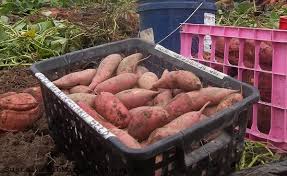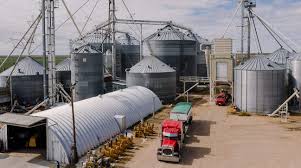High temperature and high moisture are the most significant factors affecting grain quality in storage. Each can cause rapid decline in germination, malting quality, baking quality, colour, oil composition, and many other quality characteristics.
When dried to moisture contents below the safe moisture level, cereals and pulses can be stored for periods of a year or more under a wide range of temperatures, provided that during storage the moisture level does not rise and precautions against insects are taken.
Crops producing root or stem tubers have special requirements with respect to storage because of the high moisture content of the tubers (60–80% when fresh).
Two major factors the moisture content of the product when it comes from the field and the relative humidity of the outside air during the storage period—determine the choice for the best storage.
Read Also: How often you need to Change Water in your Fish Farm
Grain Storage and Pest Control

Insects and moulds impair the quality of grain directly by their feeding and development, and indirectly through generation of heat and moisture. High temperatures and moistures favour the development of insects and moulds.
Development of insects is limited by temperatures below 15°C and by moistures below 9% in cereal grains. Development of moulds is limited by high temperature.
High moisture and high temperature are the most significant factors affecting grain quality in storage. Each can cause rapid decline in germination, malting quality, baking quality, colour, oil composition, and many other quality characteristics.
Spraying with insecticides or fumigating minimises insect problems but leaves chemical residues in grain, which break down with time.
Presence of residues and their concentration affect acceptability of the grain to markets. Some markets prefer grain without residues.
Grain buyers will not knowingly accept grain treated at rates higher than those specified on the label or within the specified withholding period.
Storage Conditions for Cereals and Pulses
When dried to moisture contents below the safe moisture level, cereals and pulses can be stored for periods of a year or more under a wide range of temperatures, provided that during storage the moisture level does not rise and precautions against insects are taken.
Insects may still develop at a relative humidity of approximately 35% and temperatures of around 15°C.
Safe Moisture Content for Selected Grains and Pulses (valid up to 27°C)
| Product | Safe Moisture Content (%) |
|---|---|
| Cereals | |
| Maize threshed yellow | 13.0 |
| Maize threshed white | 13.5 |
| Maize flour | 11.5 |
| Paddy rice | 14.0 |
| Husked brown rice | 12.0 |
| Sorghum | 13.5 |
| Millet | 15.0 |
| Wheat | 13.5 |
| Wheat flour | 12.0 |
| Pulses | |
| White and kidney bean | 15.0 |
| Cowpea | 15.0 |
| Lentil, pea | 14.0 |
The safe moisture content for any particular grain may vary slightly depending on the variety. The mentioned safe moisture contents are valid for temperatures up to about 27°C. Higher temperatures require lower moisture content maxima.
Major Factors Determining Crop Storage Methods
1. The moisture content of the product when it comes from the field.
2. The relative humidity of the outside air during the storage period.
Temporary Crop Storage Methods in Agriculture
1. Aerial Storage for Cereal Crops
Maize cobs, sorghum, or millet panicles are sometimes tied in bundles and suspended from tree branches, posts, or tight lines on or inside the house.
This method is not suitable for very small or very large quantities and does not provide protection against the weather (if outside), insects, rodents, or thieves.
2. Ground Storage or Drying Floor Storage
This method is only provisional since the grain is exposed to all pests, including domestic animals and the weather. It is usually used if the producer is attending to other tasks or lacks means of transporting the grain to the homestead.
3. Open Timber Platforms
A platform consists of horizontal poles laid on upright posts. If built inside a building, it may be 35–40 cm above ground level for easy cleaning. Platforms outside may be at least 1 m high and are usually rectangular, circular, or polygonal.
Grain is stored on these platforms in heaps, baskets, or bags. Fires may be lit underneath in humid countries to dry produce and deter pests.
Platforms may also be conical, facilitating drying due to their funnel shape. Transitional types between temporary and long-term stores include platforms with roofs but no walls, as seen in southern Benin, Togo, and Ghana.
Long-Term Crop Storage Methods in Agriculture
1. Storage Baskets (Cribs) Made of Plant Materials
In humid countries, traditional granaries (cribs) are made from timber, reeds, or bamboo. Most cribs need replacement every two or three years, though bamboo ones may last up to 15 years.
These structures always have roofs and walls and may be elevated with fire maintained underneath to assist drying. Access is often over the wall or via a gap between the roof and the wall. Few have removable floor or wall gaps.
2. Calabashes, Gourds, and Earthenware Pots
These small containers are used for storing seed and pulse grains like cowpeas. Sealed with clay, cow dung, or wooden stoppers, they can be hermetic if the grain is dry (under 12% moisture content), ensuring effective storage.
3. Clay Jars for Seed and Legume Storage
Large clay receptacles with narrow necks are sealed with a lid and clay. They are stored indoors and used for seeds and legumes. To remain effective, jars must be protected from sunlight and remain uncracked and non-porous.
4. Solid Wall Bins in Arid Regions
Common in dry areas like the Sahel, these bins allow grains to be sun-dried. Bases are made of timber, earth, or stone, though stone is best to prevent pests.
Mud or clay silos are mostly round or cylindrical and are often built using clay from termite mounds for improved plasticity. Straw may be added for strength. Capacities range from 150 kg to 10 tonnes, with wall thickness in West Africa usually between 15–20 cm.
Read Also: Worm Infestation on Ruminant Animals: Symptoms and Treatment
Underground Storage

Underground storage is practiced in countries like India, Turkey, Sahelian regions, and southern Africa. It suits dry areas where the water table is low enough to avoid damaging stored products.
Pits for storage can hold between 100 kg to 200 tons and vary in shape—cylindrical, spherical, or amphoric depending on the region. The pit entrance is sealed with earth, sand over timber covers, or stones sealed with mud.
Advantages include
- fewer problems with rodents and insects,
- lower construction cost than above-ground stores of similar capacity,
- stable and relatively low temperatures
- being hidden from thieves
- minimal need for continuous inspection.
Disadvantages include
- labor-intensive construction
- reduced seed viability over time making stored grain suitable mostly for consumption
- grains may develop fermented odors after long storage
- dangerous removal due to carbon dioxide buildup if pits are not full
- difficulty inspecting stored grains.
- risk of water penetration causing mold at the top and edges.
Cassava Storage
1. Conditions for Storage
Root crops like cassava have high moisture content (60-80%) in their tubers. Proper storage requires balancing moisture to avoid both drying out and rotting.
Tubers continue to respire after harvest, especially at higher temperatures, leading to oxygen depletion in airtight conditions, which can cause damage such as “black heart” in potatoes. Higher tuber temperatures require better ventilation.
Chemical changes during storage affect tuber firmness and taste. Tubers also have a dormancy period after which sprouting begins.
For example, yams store well for about 4 months, while potatoes start sprouting after 5 weeks at 15 °C. Rodents often attack tubers during storage.
Fresh cassava roots deteriorate rapidly due to microbial infection and physiological breakdown, not pests. Because of this, farmers often leave cassava in the ground until needed.
However, this practice reduces land productivity, causes internal discoloration making the roots unusable, increases microbial rotting, and invites rodent and nematode damage.
2. Storage Practices
Traditionally, cassava storage involves leaving roots in the ground until required or processing immediately into dried forms for longer storage. Roots left in the soil become fibrous, less palatable, and more susceptible to disease.
Another traditional method is burying roots in pits or trenches to keep them fresh for a short period. Roots can also be heaped, watered daily, and coated with a mud paste to preserve them for 4 to 6 days.
Yam Storage
1. Curing and Storage Conditions
Yams are cured at 29-32 °C and 90-95% relative humidity for 4 days to heal wounds. Only deep wounds heal well; bruised tubers require trimming before curing. Yams can store longer than cassava because of their dormancy period. Sprout removal extends storage life.
Ideal storage is at about 16 °C and 70% relative humidity, allowing storage for 3-4 months. Below 12 °C, chilling injury occurs.
2. Storage Methods
i. Barn storage: Yams tied vertically to poles, common in West Africa.
ii. Platform storage: Tubers laid horizontally on elevated platforms.
iii. Underground storage: Tubers placed in ditches and covered with soil or dry vegetation.
Good aeration and shading are essential, with frequent inspection to remove rotten or sprouting tubers.
2. Causes of Loss
Losses during yam storage arise from rotting, respiration, sprouting, and moisture loss.
3. Cold Storage
Cold storage reduces these losses but is expensive and can cause browning if temperatures drop below 10 °C.
Sweet Potato Storage

1. Curing
Sweet potatoes are cured at about 30 °C and 85-90% relative humidity for 5-7 days. They can be left in the field in small heaps covered at night if temperatures drop below 25 °C. Curing promotes wound healing and reduces storage losses.
2. Storage Conditions
Optimal storage temperature is 13-16 °C with 85-90% relative humidity. Higher temperatures cause sprouting and increased respiration, leading to quality loss.
3. Storage Methods
i. Clamp storage
ii. Pit storage lined with straw or bamboo and covered tightly, suitable where drainage is good
iii. Hut storage
Tubers can also be wrapped in dry sawdust or newspaper to reduce moisture and sprouting.
4. Storage Challenges
Sweet potatoes have limited storage potential in the tropics. Red varieties generally store better than white ones. Processing into chips or flour can reduce losses.
Irish Potato Storage
1. Storage Conditions
Irish potatoes store best below 10 °C in dark, dry, and well-ventilated places. They should not be exposed to sunlight for more than one hour to prevent damage.
2. Storage Methods
1. Clamps or partially underground pits: Straw layers are sometimes topped with sand after a week to reduce respiration.
2. Hut storage: Ventilated during cooler nights, often with air ducts to bring in cool air.
3. Bulk or small box storage.
Oil-Containing Products Storage
Oil-containing crops like groundnuts, soybeans, sesame, and coconut are stored either for direct consumption or oil extraction.
The quality of oil depends on the free fatty acid content, which increases with temperature, humidity, and damage from insects or fungi.
Fungal growth can cause toxic aflatoxin, especially in groundnuts. Safe moisture content limits for storage are 7% for groundnuts and copra, 5% for palm kernels, and 10% for cotton seed.
Groundnuts, soybeans, and sesame are dried in the field before threshing. Hand threshing at about 15% moisture content reduces damage, while mechanical threshing allows slightly wetter crops to be processed.
Palm kernels require thorough drying to about 6% moisture to prevent spoilage. Coconuts are dried for 60–80 hours under sun or artificial heat, avoiding rain and dew.
Do you have any questions, suggestions, or contributions? If so, please feel free to use the comment box below to share your thoughts. We also encourage you to kindly share this information with others who might benefit from it. Since we can’t reach everyone at once, we truly appreciate your help in spreading the word. Thank you so much for your support and for sharing!

